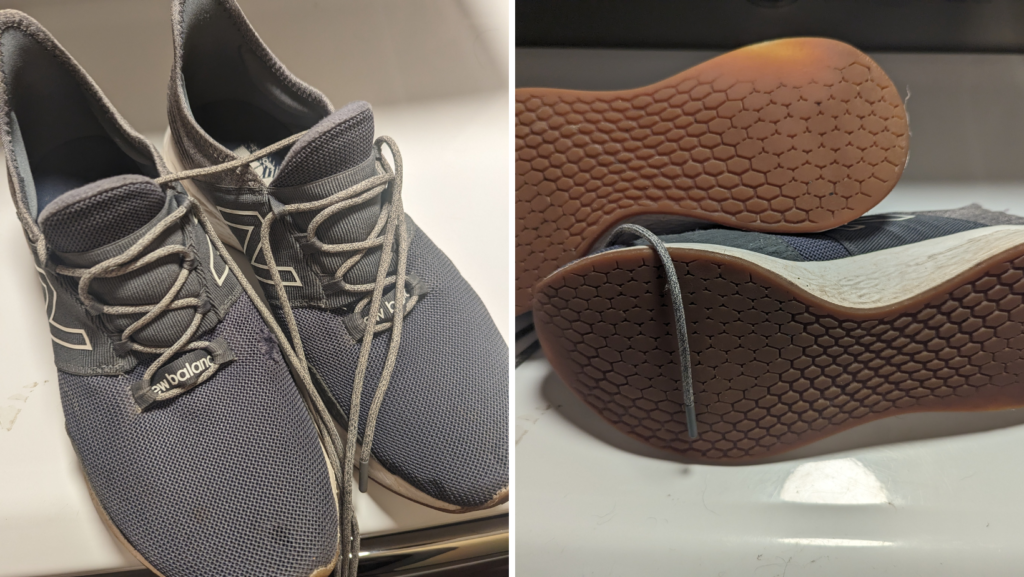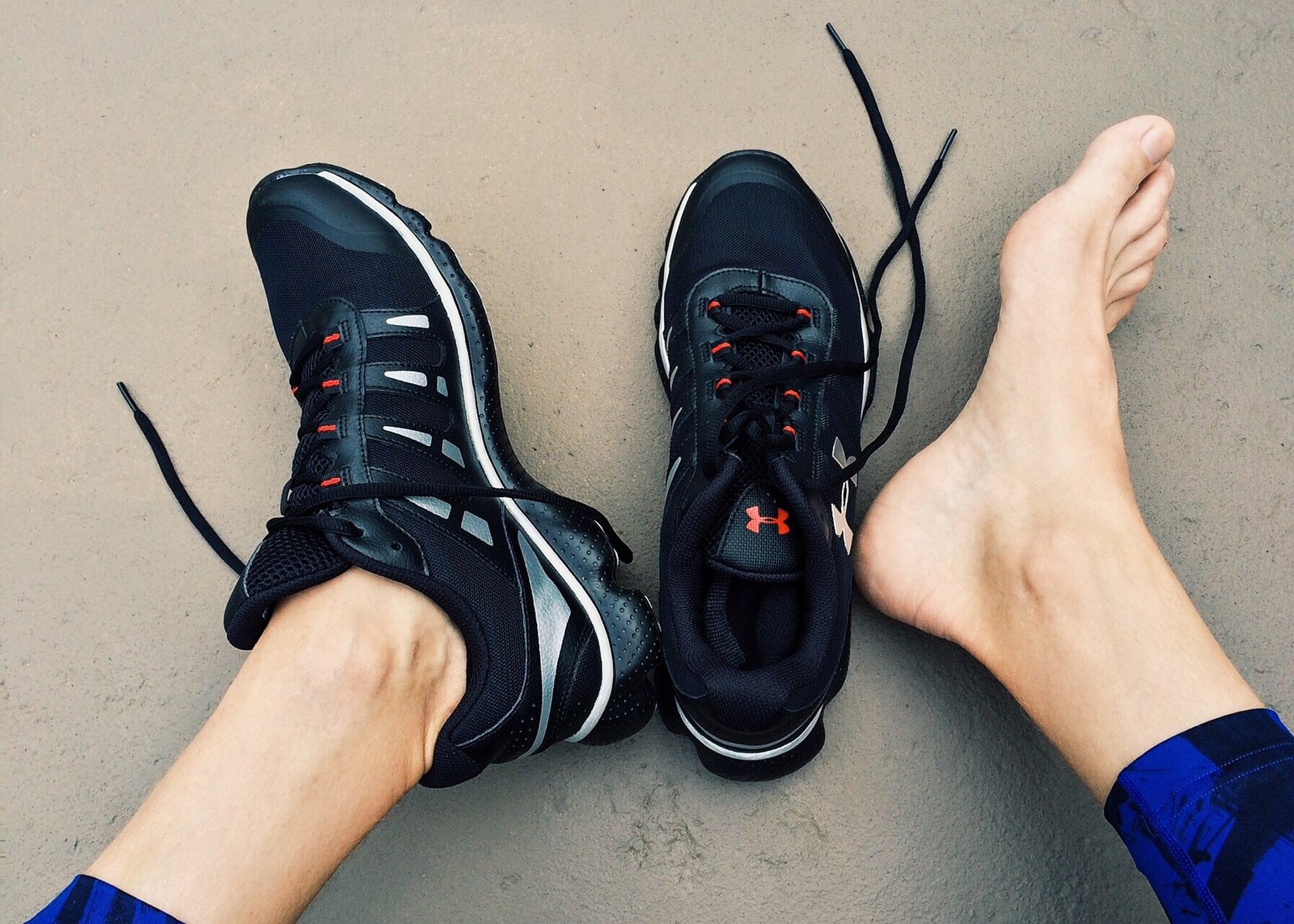If you’ve been running for any length of time, you’ve probably wondered – how often should I replace my running shoes? How many miles should they last?
Some general and oft repeated advice is that you should replace your shoes every 300 miles. I’ve heard that suggestion many times. And when I was first starting out, it seemed reasonable. 300 miles is a lot, right?
But now that I’m running 60, 70, or 80 miles a week, it doesn’t seem like that much. The notion that I would have to replace my shoes just about once a month seems crazy.
So how long do running shoes really last?
What Makes a Running Shoe “Used Up”
To get a better handle on when you should retire your running shoes, it might help to first think about what criteria you should use to determine if your shoes are still good.
You can narrow down the wear and tear to three general areas – the upper, the sole, and the foam.
There are a variety of ways that the upper of your shoe can get worn out. If you go trail running, you might suffer some scratches and rips. Given enough time, it’s not uncommon for your big toe to wear a hole in the top of your shoe. At some point, you may decide that this wear and tear is too much – but as long as you can lace up your shoes this is really cosmetic stuff.
The outsole is in constant contact with the ground as you run and that friction will wear it down over time. They’re kind of like the tires on your car. At some point, the tread pattern will be worn down to rubber – and if you keep going you’ll wear the rubber right off. This can become a real issue. The tread on your soles helps with traction. Depending on weather conditions and running surface, this loss of traction could be a big deal.
Finally, there’s the cushioning in the midsole of the shoe. Unless you’re running in minimalist shoes, your running shoes probably have some kind of foam in the midsole to absorb the impact of each foot strike. So-called “super shoes” also include a carbon plate to help return more energy and improve running efficiency. Both of these things have a limited life span, and they will eventually wear out.
It is possible that worn out foam can make you more susceptible to injury, and that’s never a good thing. And if your racing shoes wear out, you won’t get the same benefit to your running economy and race performance.
What’s the Lifespan of Modern Running Shoe Foam?
Most of the advice around replacing your shoes based on mileage is focused on the wear pattern of the cushioning.
There have been a number of research studies that look into this issue.
One study (by Cornwall et all, 2017), based on a sample of fifteen recreational runners, determined that cushioning was reduced by 16% to 33% after 640km (approximately 400 miles). Interestingly, the runners themselves could not reliably identify this change.
Another study (by Cook et al, 1985) tested about two dozen different types of shoes. They used a machine to simulate running, and they also tested shoes worn by actual runners. In both cases, there was a significant reduction in cushioning after 100 to 150 miles. Smaller reductions continued until 500 miles – the highest mileage tested. However, the shoes used by actual runners showed less compaction of the foam. The results were consistent with the previous study, with cushioning being reduced by about 30% after 500 miles.
A final study (by Wang et al, 2010), based on a sample of fifteen amateur runners, found that there was a small but significant decrease in cushioning after 500km (approximately 300 miles). This particular study also emphasized the fact that compaction of the midsole was less prominent when actual runners used the shoes. Many previous studies had been done with machines that simulated running, and these studies may have overstated the effect.
Another common theme in these studies was that it was focused on heel striking runners. From an injury prevention perspective, the cushioning may be less important for runners who do not heel strike.
While this isn’t an exhaustive literature review, it suggest a few things:
- There is a significant reduction in cushioning over the life of your shoe
- This reduction may be overstated in some studies due to their methodology
- This may be most important for heel striking runners
Does Rotating My Shoes Help Then Last Longer?
One piece of advice that I’ve heard to extend the lifespan of a shoe is to rotate it with other shoes.
As the theory goes, the midsole takes time to recover in between runs. If you run in the same shoes every day, the foam cannot recover sufficiently and its lifespan will be shortened. Instead, if you rotate two pairs of shoes, each will be able to recover somewhat on the off day. As a result, the foam will last longer.
This always smelled like horse shit to me.
While I was reviewing the scientific literature, I noticed that Cook et al tested for this specifically. They found that there was no significant difference when shoes were used once a day and when they were rested in between runs.
One research study is not necessary definitive – so when I get a chance I want to look for some confirmation of this. But this supports my own hunch that rotating shoes will not extend the lifespan of your shoes.
That being said, it’s worth rotating shoes if you need different shoes for different runs. I have two main types of daily running shoes – road shoes and trail shoes. I also have a pair of faster shoes for days when I’m on the track. But I don’t have any expectation that this rotating will increase the number of miles I can run in a given pair of shoes.
Do Old, Worn Out Running Shoes Lead to Injury?
This is one of the most oft-repeated pieces of advice given to new runners – change your shoes often, because old shoes will lead to injuries.
Here again, there is some research to help answer the question.
Rachel Nichwitz (2019) studied this in her thesis. Based on a sample of female college cross country runners, there was no significant correlation between shoe mileage and injury. Another study by Rethnam and Makwana (2011) found, counterintuitively, that it was new shoes that placed the most pressure on your feet as compared to old shoes. A 1992 literature review by Mechelen found, among other things, that there was little evidence that running shoes were related to running injuries.
I’m a bit skeptical of the claim that old shoes lead to running injuries, and that skepticism seems to be supported by this research. It’s entirely possible that other things are causing over ruse injuries, and people are simply attributing these to their old shoes.
But this is an area I’m interested to look further into the research. I’ll probably expand on this in another article when I have time to do a proper literature review myself.
Let’s Look At My Recently Retired Shoes
It’s the beginning of a new year, and for me that means it’s time to break out some new running shoes.
It also means it’s a good time to take a look at the condition of my previous running shoes – and think about whether and why it might have been the right time to retire them.
First up are my trail running shoes – the New Balance 481v3.

These bad boys have seen a lot of use. With the exception of some snowy days at the beginning of 2022, where I used Yaktrax on my old trail shoes, this pair lasted me the entire year.
I ran a little over 3,000 miles last year, and I’m guessing that somewhere between 1,000 and 1,500 of them were on trails. I’d conservatively guess that these shoes have at least 1,000 miles on them.
And they look pretty good all things considered. The soles look fine, and there’s lots of tread left. The uppers are getting a little worn out, and there were a few holes in the top. I don’t feel a lot of cushioning in these, so I’m not really worried about the foam. I probably could have ridden these a little longer, but they’re not expensive so I just chucked them and broke out a new pair for 2023.
Next up are my road shoes – the New Balance Fresh Foam Roav.

I went through two pairs of these shoes last year. I started using this pair in July, and used them for six months. I ran a little over 1,400 miles in those six months, and I’d estimate that these shoes probably covered 700 to 800 of those miles.
The soles have noticeable wear on them. The outside portion near the heel has no tread left, and it’s almost completely worn through. My previous pair, which I used from January to June, looked similar by the end. The uppers aren’t too bad. There’s a spot wearing thin near my big toe in each shoe, and one shoe has a rip on the side from one particular day that I fell. The foam is a bit less cushiony than in the beginning, but frankly they didn’t seem too bad.
For me, the issue with the outsole is the clearest reason why these needed to be retired.
So How Often Should You Actually Replace Your Running Shoes?
In my opinion, you shouldn’t be overly concerned about how much mileage you have in your shoes.
Some runners will scare you into thinking that if you put more than 300 or 400 miles on your shoes, you’re running the risk of injury. While it’s true that mileage leads to a reduction in midsole cushioning, there’s just not a lot of evidence that this also leads to an increased risk of injury – or if there is a risk of injury it’s minor compared to other things like training load.
Personally, I’m more concerned about the health of my running shoe’s upper and outsole. When one or both of these get worn out, I’m ready to replace a shoe.
How often this happens is going to be based on how many miles you run each week, but you don’t have to worry about changing shoes every 300 miles. In my experience, running shoes will last at least 500 miles – and some may last up to 1,000.
I tend to simply replace my shoes on a schedule – every six months, I break out a new pair. This means that January 1 and July 1 are my “new shoe” days. Given my rotation of trail and road shoes, I usually don’t have a problem with getting six months out of a given pair of shoes.
So don’t let people scare you. If your shoe still works, and it’s still comfortable, then you can keep running in it.
